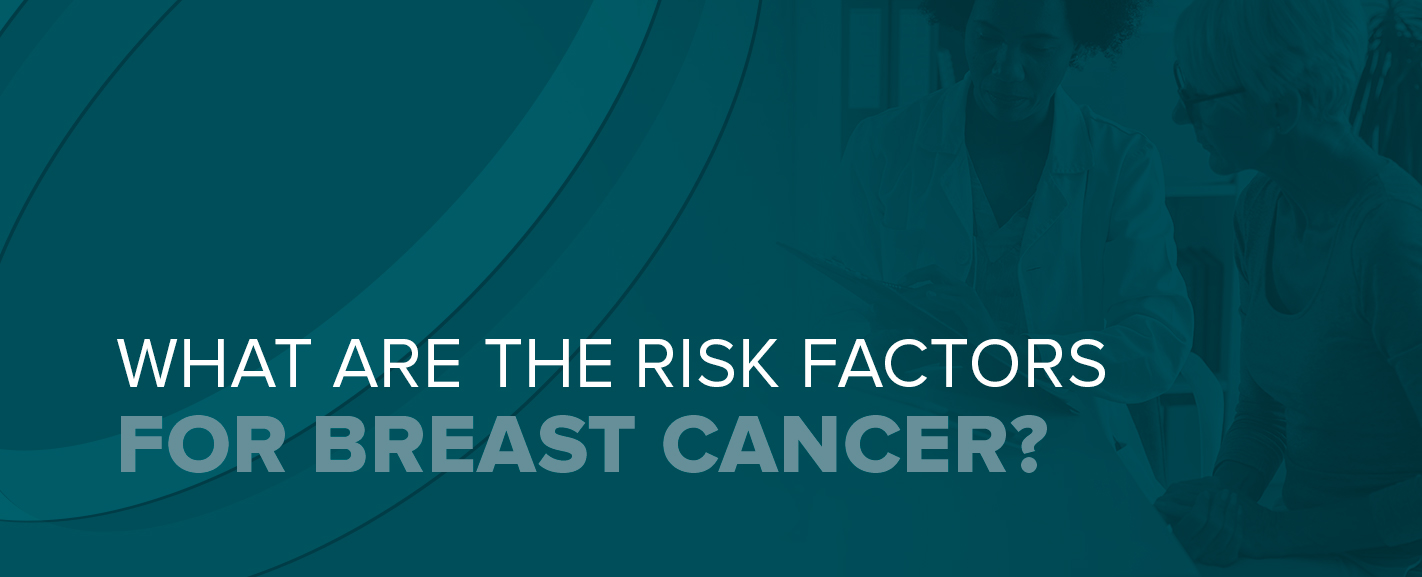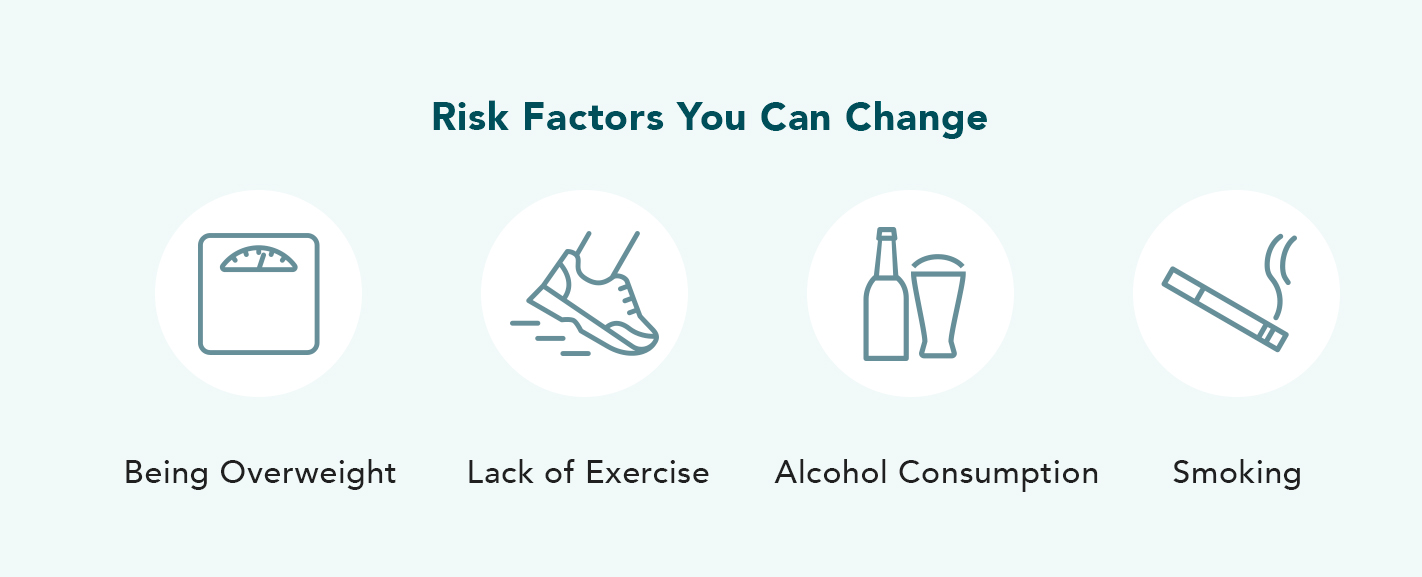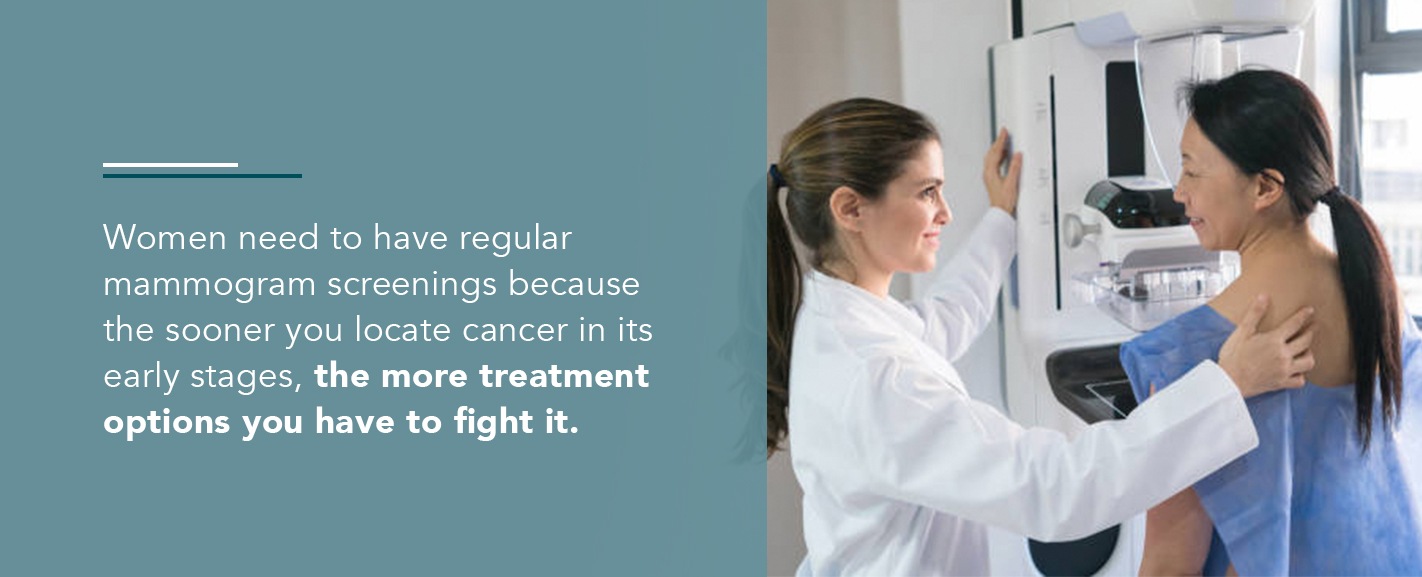What Are the Risk Factors for Breast Cancer?
Odds are, you know someone who has experienced or is experiencing the fight against breast cancer. Breast cancer is one of the most common forms of cancer in American women, with new cases affecting nearly 300,000 women this year alone.
Every woman has some risk of breast cancer, but certain risk factors can increase the chance of its development. The most important thing you can do is to establish a line of communication with your doctor. Talk about the possible risk factors, including the ones you can and cannot change, and schedule routine mammogram screenings to best manage breast cancer development.
Breast Cancer Risk Factors You Can Change
Risk factors don’t indicate the presence of breast cancer. Rather, they are signs you may be more prone to developing breast cancer in the future. Some lifestyles can increase your breast cancer risk, including changeable causes of breast cancer such as:
1. Being Overweight
Women with a body mass index (BMI) of over 25 have a higher risk of developing breast cancer, particularly in overweight women post-menopause. Having more fat tissues — your body’s primary source of estrogen after menopause — means having a higher amount of estrogen, which can increase breast cancer risk.
2. Lack of Exercise
Growing evidence supports the claim that regular exercise can reduce the risk of breast cancer. The American Cancer Society suggests that adults practice 150 to 300 minutes of moderate-intensity exercise — or 75 to 150 minutes of vigorous-intensity activity — every week. Exercise limits the levels of insulin growth factor, a tissue-development hormone that can affect the way breast cells grow.
3. Alcohol Consumption
Breast cancer risk increases with the amount of alcohol you drink. Alcohol increases your estrogen levels and limits your liver’s ability to control the heightened estrogen in your blood. Additionally, alcohol damages the DNA in your cells, making you more vulnerable to breast cancer.
4. Smoking
Smoking has links to multiple diseases, including breast cancer. Premenopausal women who smoke, or those exposed to heavy secondhand smoke, have a higher breast cancer risk than women who don’t.
Schedule a Mammogram With Envision Imaging
Breast Cancer Risk Factors You Can’t Change
The most predominant risk factors for breast cancer are those you cannot change, like your:
1. Gender
Breast cancer is commonly thought to be a disease that affects only women, but it can also occur in men. Being a woman is the most significant risk factor of breast cancer, as men make up less than 1% of new cases.
Women’s breast cells are in a constant state of changing and growing. Fully formed breast cells are very responsive to the hormones estrogen and progesterone, which some breast cancers are sensitive to. Comparatively, most men’s breasts consist of fat rather than fully formed glands, greatly decreasing their breast cancer risk.
2. Age
The risk of breast cancer increases as you get older. The same goes for other diseases because our body’s ability to repair genetic damage decreases as we age. For example, 1 in 209 women in their 30s were diagnosed with invasive breast cancer in 2019, compared to the 1 in 28 women diagnosed in their 60s within the same year.
3. Race
White women are at a slightly higher risk of developing breast cancer than Black, Asian, Hispanic and Native American women. Studies indicate these differences may be due to lack of access to health care and other preventative measures, as well as respective lifestyle patterns, such as eating and bodyweight disparities.
4. Family History of Breast Cancer
Two types of DNA changes can cause mutations that increase your risk of breast cancer — those you inherit from your relatives, or those that occur over time. It’s thought that 5% to 10% of breast cancers result from abnormal genes passed down from family members.
If you have a first-degree relative — such as your mom, sister or daughter — who gets diagnosed with breast cancer, your risk of developing it doubles. Or, if you have multiple relatives with either breast or ovarian cancer, you could be at a higher risk, too.
5. Breast Density
Dense breasts, consisting of less fatty tissue and more non-fatty tissue, can be inherited from your family. Studies show that having dense breasts can increase your risk of breast cancer by almost twice the amount of non-dense breasts, and this can also make cancerous structures harder to detect in mammograms.
6. Personal History
If your doctor already diagnosed you with breast cancer, then your risk for developing another new form in either the same or the other breast increases by 3 to 4 times. Other benign conditions can affect your breast cancer risk, too, such as:
- Growth of abnormal-looking cells: Cells in the breasts grow faster than usual and have an abnormal appearance. A diagnosis of proliferative lesions with atypia can increase your risk of breast cancer by 4 to 5 times.
- Rapid growth of normal-looking cells: If cells in your breasts grow faster than usual but still look normal, which doctors call proliferative lesions without atypia, then your risk of breast cancer can double.
- Lobular carcinoma in situ (LCIS): Women diagnosed with LCIS, abnormal cell growth within the breast, can have an increased breast cancer risk of 7 to 11 times.
If you have a personal and family history of breast cancer, you may be at a higher risk. Talk to your doctor about your history with breast cancer, and practice routine mammogram screenings to monitor any possible developments.
Why It’s Important to Have a Regular Mammogram
A mammogram is a low-dose x-ray image of your breasts. Mammograms are performed annually as a precautionary screening measure, or for women experiencing symptoms of breast cancer.
Women need to have regular mammogram screenings because the sooner you locate cancer in its early stages, the more treatment options you have to fight it. Using your mammogram screening, your doctor can assess the presence, or lack thereof, of cancer up to three years before it can be felt during routine gynecological visits or self-examinations.
What Happens During a Mammogram Screening?
Before your screening, your doctor will ask you to undress from the waist up. You can wear a two-piece outfit to make this step more comfortable. Once you and your doctor are ready, they will guide you to stand in front of the mammography machine.
The actual x-ray imaging process only takes a few moments. Your doctor will position one breast to a flat surface, then gradually compress your breast using a paddle for the most accurate breast imaging. After the first breast, your doctor will do the same to the other. Depending on your breast size and pain tolerance, you may find this step uncomfortable, but it will last only a few short moments.
After your appointment, you can return to your daily routine as normal. Your doctor will contact you within 30 days, either with a letter stating your results showed no signs of breast cancer or with a gentle request to return to the office for further screening.
Find an Envision Imaging Center Near You
Our world-class radiologists at Envision Imaging value your safety and comfort. We put our patients’ needs first, providing the fastest diagnostic images using the latest, cutting-edge imaging technology for a better overall experience.
Schedule an appointment at a mammogram imaging center near you. You can find our Envision Imaging centers in Colorado, Oklahoma, Texas and Louisiana and at the Women’s Center at Colorado Springs Imaging.
Call To Schedule Your Appointment
Sources:
- https://www.cancer.net/cancer-types/breast-cancer/statistics#:~:text=More%20women%20are%20diagnosed%20with,(in%20situ)%20breast%20cancer.
- https://www.cancer.org/healthy/eat-healthy-get-active/acs-guidelines-nutrition-physical-activity-cancer-prevention/guidelines.html
- https://www.breastcancer.org/research-news/higher-bmi-and-risk-for-premenopausal
- https://www.breastcancer.org/symptoms/types/male_bc#:~:text=Breast%20cancer%20in%20men%20is,is%20about%201%20in%20833.
- https://www.cancer.org/content/dam/cancer-org/research/cancer-facts-and-statistics/breast-cancer-facts-and-figures/breast-cancer-facts-and-figures-2019-2020.pdf
- https://www.breastcancer.org/risk/factors/race_ethnicity
- https://www.breastcancer.org/risk/factors/genetics
- https://www.breastcancer.org/research-news/family-history-increases-risk-in-other-breast
- https://www.breastcancer.org/risk/factors/dense_breasts
- https://www.breastcancer.org/risk/factors/personal_history
- https://www.breastcancer.org/risk/factors/breast_changes
- https://www.envrad.com/signs-and-symptoms-of-breast-cancer/
- https://www.envrad.com/what-doctors-look-for-on-mammograms/
- https://www.envrad.com/what-not-to-do-before-mammogram/
- https://www.envrad.com/about-us/why-choose-us/
- https://www.envrad.com/locations/





